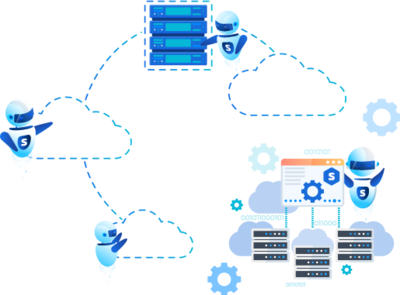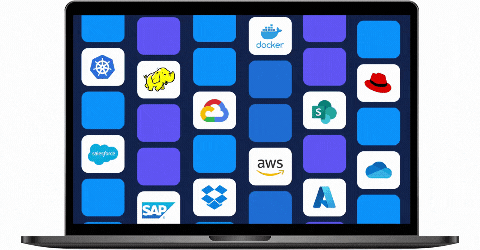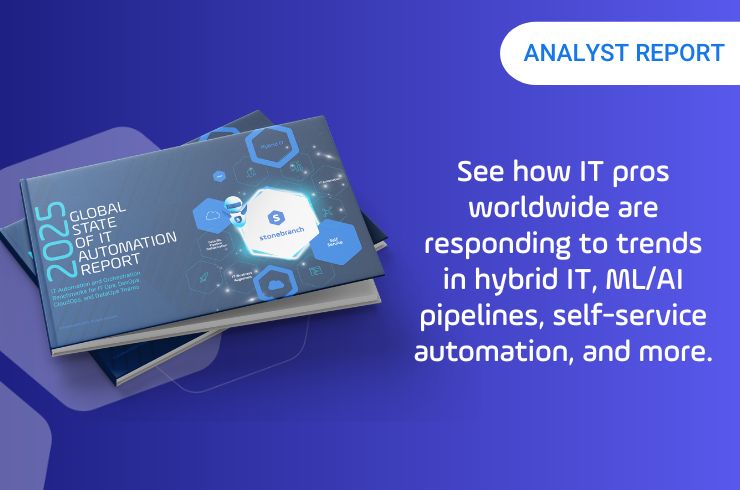Stonebranch Solution
Comprehensive Cloud Service Automation Solutions
Centrally control automated IT processes across private and public cloud, multi-cloud, and on-premises hybrid IT environments – all from a single solution designed for real-time, event-based automation.
A Cloud Automation Solution That Goes Beyond the Cloud
With the cloud automation solution, part of the Universal Automation Center (UAC), enterprises have the power to orchestrate IT processes, schedule cloud workloads, spin up cloud infrastructures, and manage data transfers across and between any cloud environment.
In addition, the UAC helps you bridge the automation gap between on-premises and cloud-based solutions. It's built for cross-team collaboration, so you can easily automate and centrally manage workloads across the boundaries of your entire hybrid IT environment.

Across and Between Cloud, On-Premises, and Containerized Systems
The UAC is a single platform that orchestrates all automated IT processes — while enabling collaboration between IT Ops, cloud architects, developers, data teams, and more.
- Cloud services automation in AWS, Google Cloud Platform, Microsoft Azure, and other providers
- Transfer data between on-premises and cloud solutions, or across multiple clouds
- Intelligent event-based scheduling for real-time automation
- Automated cloud infrastructure deployment
- Redirect overflow traffic with cloud bursting
- Container-based workload management — schedule jobs within containers
- Role-based self-service access to support cloud architects, developers, data teams, IT Ops, and others
- DevOps ready — deliver jobs-as-code
- SaaS-based or on-prem deployment options
Watch this 2-Minute Demo of Stonebranch's IT Automation Platform in Action.

Connect to and Schedule Automated Jobs Within any Cloud Platform or SaaS Application
Integrations between the UAC and your cloud technology stack allow you to perform cloud scheduling directly from the UAC — eliminating the need for custom scripts, clunky open-source schedulers, or managing a myriad of tool-specific in-built job schedulers.
- Integrate the UAC with any platform or application within your cloud environment
- Download pre-designed cloud integrations from the Integration Hub
- Easily create integrations on your own with templates and rich documentation
- Build your own custom integrations with Stonebranch developers
Cloud Automation Use Cases
The UAC provides IT Ops with centralized control and security, while cloud architects, data teams, and developers are empowered to create automated processes with the speed and agility they require.
Multi-Cloud
Orchestration
Automate and schedule workloads in AWS, GCP, Azure, and more — enabling real-time workflows that span across your multi-cloud environment. Additionally, transfer data directly to, from, and between cloud service providers (CSP), SaaS applications, and even on-premises tools.
Cloud Infrastructure
Automation
Centrally automate (remote) server provisioning and configuration. Add cloud service providers to your automation workflows for enhanced automation capabilities. Integrate with and control automated processes within pure-play integration management solutions, like Ansible, Terraform, or Puppet.
Hybrid Cloud
Data Transfer
By combining the UAC's advanced scheduling engine with its in-built managed file transfer capabilities, you can securely transfer data between your local file server, mainframe, or SAN; and your cloud service providers, including AWS S3; and cloud storage platforms, like Azure Storage, Google Cloud Storage, SharePoint and OneDrive; and more.
Simplify Cloud
Migrations
Move workloads to the cloud without ever missing the benefits of automation. When migrating applications to the cloud, allocate the resources needed to execute workloads at runtime without changing workload definitions.
Containers/Microservices Automation
Seamlessly deploy UAC agent technology in containers. Use its powerful scheduling capabilities to deploy a container with a set of microservices, execute the microservices, safely store the results, then stop and remove the container. Easily integrate with container management platforms like Red Hat OpenShift.
Cloud Infrastructure
as-a-Service
Allow non-IT staff to turn cloud infrastructure on and off — while IT centrally regulates which cloud providers and how much is allowed. End-users gain speed and productivity; IT gains end-to-end visibility and control.
Demo Video: Multi-Cloud Data Transfer
Easily transfer data to, from, and between any of the major cloud providers in a multi-cloud environment.
Integration Hub
Discover popular cloud integrations for AWS, MS Azure, Google Cloud (GCP), Kubernetes, Docker, more.
Managed File Transfer
Combine powerful Managed File Transfer (MFT) capabilities with cloud scheduling capabilities.
Part of a Full IT Automation Platform
This modern automation platform gives you the ability to manage and control processes in real-time across any on-prem, cloud, or hybrid IT environment. The Stonebranch Universal Automation Center and its software components are available to be deployed on-premises or via SaaS.
Universal Automation Center
The most modern and flexible real-time IT automation platform.
Learn more
Universal Portal
Extend power to end-users, or citizen automators, in both technical and non-technical roles.
Learn more
Universal Controller
Command center-like management, control and monitoring.
Learn more
Universal Agent
Execute any kind of automation process on any remote system.
Learn more
Universal Data Mover
Automate your data pipeline with secure and reliable managed file transfer.
Learn more
Universal Data Mover Gateway
Securely manage platform independent B2B file transfers with third party vendors.
Learn more












